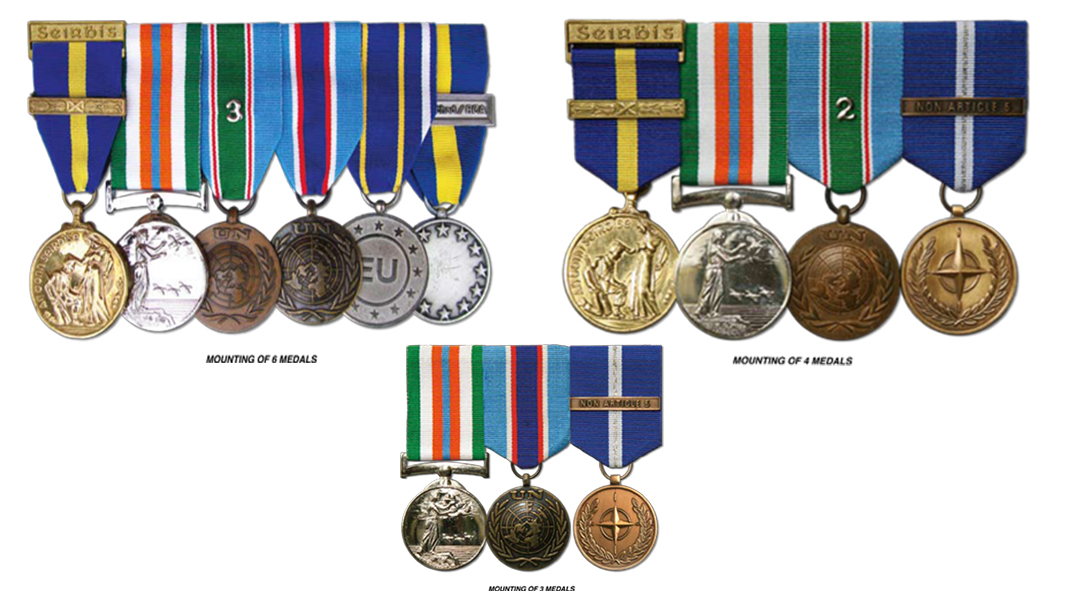Military medals are bestowed in recognition of specific acts or service which can vary in signifigance from routine duty to bravery and valour. Military medals are highly valued and are regarded as representing all that is best in the field of human endeavour.
Medals in the Defence Forces fall into two broad categories: medals awarded by the Minister for Defence on the recommendation of the Chief of Staff and medals awarded to qualifying personnel for service overseas on Government approved missions.
Method of Wear
Army and Air Corps
Medals are to be worn over the left breast pocket. Pipe bands and pipers when on ceremonial duties shall wear their medals over the Tara Brooch.
Naval Service
Medals shall be worn by Leading Seamen and Seamen centrally on the left breast of the jumper with the clasps in line with the top of inner pocket. For all other Naval ratings, medals shall be worn centrally on the left shoulder of the coat with clasps in line with the cut of the lapel.
Multiple Medals
A single Medal shall be suspended from a suspension bar. Two to five medals inclusive shall be suspended from a single suspension bar of sufficient length to carry the required number of medals without overlapping. Where six or seven medals are worn, they shall be evenly overlapped on a suitable five-medal suspension bar. The premier medal shall be fully uncovered. Where more than seven medals are worn, a second row of medals shall be worn. In such cases a maximum of five medals will be mounted on both rows before overlapping begins in the top row. The Military Medal for Gallantry and the Distinguished Service Medal will be worn individually and generally above any other row of medals.
Occasions When Worn
Unless otherwise ordered, medals shall be worn when attending:
- The National Day of Commemoration
The inauguration of An tUachtarán and other ceremonies attended by An tUachtarán
The presentation of letter of credence by an Apostolic Nuncio designate, an ambassasdor or minister designate
The Annual 1916 commemoration ceremony
Commissioning ceremonies
The annual commemoration Mass for deceased officers and enlisted personnel
By officers and enlisted personnel of Guards of Honour and Escorts of Honour
By memebers of the court at a court martial
On state and military funerals by pall bearers; marshals; escort; firing; bearer parties and bands
On such other occassions as may be authorised by the Deputy Chief of Staff (Support), or the General Officer Commanding a brigade or formation.
Medals shall not be worn
- At a ceremony for the award of an order, decoration or medal
At a banquet, formal dinner or an official reception, unless indicated by the host
With or on greatcoats or overcoats
By an officer or an enlisted person in custody
By enlisted personnel undergoing imprisonment or detention

Wearing of Medals on Civilian Attire
Serving personnel, including 1st Line Reserve and Reserve Defence Forces shalll not wear medals on civilian attire. Retired personnel may wear medals on civilian attire on the same occassions as when medals are worn by serving personnel, and in a similar manner.
Family Members
Next of kin should not wear the medals of a deceased family member, except when the medal is awarded posthumously. Medals are awarded to individuals in recognition of specific acts or service and should only be worn by the individual to whom it was awarded. Family of deceased members of the Defence Forces should only wear the following medals when the decoration is presented directly to the next of kin.
- The Military Medal for Gallantry
- The Distinguished Service Medal
- The Military Star
- The Service Medal
- The United Nations Peacekeeping Medal
Mounted Medals
The above information is an extract from the Medals of the Defence Forces publication (2010). The publication contains more information about medals and the various medals that have been awarded.
Download the publication Medals of the Defence Forces (pdf 9.9Mb)
Download The Military Service (1916 -1923) Pensions Collection - The Medals Series
